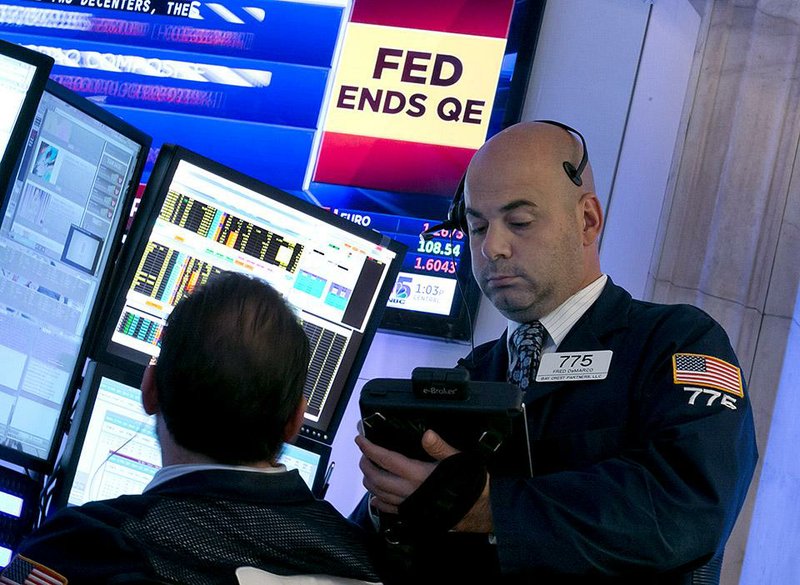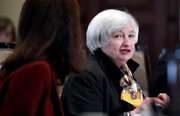WASHINGTON -- Citing an improving economy, the Federal Reserve on Wednesday ended its landmark bond-buying program as it pointed to gains in the job market -- a key condition for an eventual interest-rate increase.
The Fed reiterated its plan to maintain its benchmark short-term rate near zero "for a considerable time." Many economists predict that means the Fed won't raise that rate -- which affects many consumer and business loans -- before mid-2015.
With Wednesday's decision, Fed Chairman Janet Yellen is completing two years of bond purchases that started under her predecessor, Ben Bernanke.
The bond-purchase program was designed to keep long-term rates low to encourage borrowing and stimulate the economy after the Fed had reduced its benchmark interest rate as low as it could. Monthly bond purchases in the billions of dollars resulted in the Fed's assets reaching $4.5 trillion before the decision to curtail the program.
Yellen must now chart a course toward the first interest-rate increase since 2006 while confronting risks from a slowing global economy and declining inflation.
The Federal Open Market Committee repeated it will consider a wide range of information in deciding when to raise the federal funds rate, which has been held near zero since December 2008.
In a statement ending Wednesday's policy meeting, the Fed noted that the job market is strengthening. Its statement dropped a previous reference to "significant" in referring to an "underutilization" of available workers.
Instead, the Fed said the excess of would-be job holders is "gradually diminishing." It also noted solid hiring gains and a lower unemployment rate, now 5.9 percent.
One of the Fed's major goals is to achieve maximum employment, which it defines as an unemployment rate between 5.2 percent and 5.5 percent.
Investors responded to confirmation that the Fed would end its bond-buying program and perhaps move toward a rate increase by positioning themselves for higher rates.
The dollar rose against other currencies, bond yields rose and the price of gold fell.
The major stock indexes fell slightly Wednesday, with the Dow Jones industrial average down 31.44 points, or 0.2 percent, to 16,974.31; the Standard & Poor's 500 fell 2.75 points, or 0.1 percent, to 1,982.30; and the Nasdaq composite fell 15.06 points, or 0.3 percent, to 4,549.23.
By contrast, when Bernanke, then the Fed chairman, first hinted in the summer of 2013 that the bond-buying program would end, investors panicked and markets convulsed.
But the Fed has since avoided all the drama by loudly announcing a schedule for the retreat and then adhering to it with absolute fidelity.
"The exit protocol has been so well documented for the last nine months that the market has fully priced it in," said Barbara Cummings, who manages a $3.5 billion fixed-income portfolio for Boston Private Wealth Management, a new subsidiary of Boston Private Bank & Trust Co.
"I don't anticipate any movement. I feel as though this is one meeting where they almost don't need to hold it because they have made it perfectly clear."
The Fed's decision to end its third round of bond-buying had been expected. It has gradually pared the purchases from $85 billion in Treasury and mortgage bonds each month to $15 billion.
The Fed had said it likely would end the program after its October meeting if the economy continued to improve.
Even with the end of bond purchases, the Fed's investment holdings stand at $4.5 trillion -- more than $3 trillion higher than when the bond purchases were begun in 2008 at the height of the financial crisis. The Fed has said it won't begin selling its holdings until after it starts raising short-term rates.
As the Fed winds down its unprecedented stimulus program, the European Central Bank is contemplating its own program to tackle the weakest inflation in five years, and Japan is continuing purchases.
A cooling global economy and declining inflation are posing risks to the outlook for the U.S., which saw growth accelerate in the second quarter to the fastest pace since 2011 and unemployment drop to a six-year low last month. Still, the housing industry is struggling, and global weakness poses a potential threat to U.S. growth.
"The U.S. is a big bright spot in the world," said Stephen Cecchetti, professor of international economics at Brandeis International Business School in Waltham, Mass., and a former New York Fed research director. "Europe is still struggling quite a lot, Japan seems to be up and down, and China's having some growing pains at this point."
On Wednesday, the Fed repeated previous language that the likelihood of inflation running persistently below its 2 percent target rate has diminished, even though inflation is being restrained by lower energy prices and other factors. The Fed noted, though, that investors foresee even lower inflation.
The Fed's statement was approved 9-1.
The one dissent came from Narayana Kocherlakota, president of the Fed's regional bank in Minneapolis. He contended that the Fed should have signaled its intention to maintain a record-low benchmark rate until the inflation outlook has reached the central bank's 2 percent target. And he argued that the Fed should have continued its bond purchases at the current pace.
On balance, economists saw the Fed's statement as showing less concern about unusually low inflation, which has helped delay a rate increase. Some analysts said the market reaction Wednesday suggested that investors saw the Fed statement as at least setting the stage for rate increases starting sometime next year.
Michael Hanson, senior economist at Bank of America Merrill Lynch, said the Fed still appears likely to put off any rate increase until at least mid-2015.
"This isn't the Fed rushing to the exits," he said.
Hanson noted that while the Fed kept its "considerable time" phrasing, it added language stressing that any rate increase would hinge on the economy's health. Previously, many analysts had interpreted the "considerable time" phrase to mean the Fed wouldn't raise rates for a specific period after it ended its bond purchases.
However, David Jones, chief economist at DMJ Advisors, said he was struck by the absence in the statement of any mention of global economic weakness, including the threat of another European recession.
A number of officials said the five-year U.S. expansion "might be slower than they expected if foreign economic growth came in weaker than anticipated," minutes of the Sept. 16-17 Open Market Committee meeting show.
Fed Gov. Daniel Tarullo said at an Oct. 11 event in Washington that he's "worried about growth around the world."
Information for this article was contributed by Martin Crutsinger and Christopher S. Rugaber of The Associated Press; by Jeff Kearns, Christopher Condon and Hugh Son of Bloomberg News; and by Binyamin Appelbaum of The New York Times.
A Section on 10/30/2014

